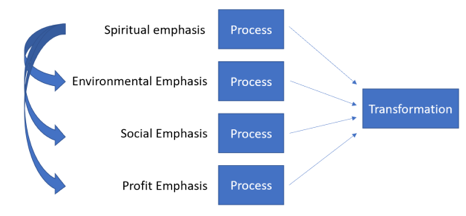
Part 1 of a mini two part series.
Maximization is a much older buzz word in the business world than “sustainability,” yet it certainly has never gone out of vogue. Maximizing shareholder value, maximizing profit, and their converse maxims, minimizing costs, etc. have their place in a plethora of management books as well as textbooks (especially in microeconomics). Yet B4T land is a far more complex system, and we need a bit more of an engineer’s outlook to fully grasp our situation. Allow me to explain.
At a chemical plant, there are many processes involved to create a final output. For “maximum” output, these processes must not be maximized. If any one process is maximized, the entire system could explode (literally). Instead, each process is optimized so that there is one global maximum (the output). Similarly, in B4T we don’t just care about one thing. If profit is all we cared about, our model would be far simpler and we may be equally as obsessed with “maximization” as the world around us. Yet for us, profit serves a much larger master: transformation. We must make a profit (of course there are exceptions) to serve the overall goal of transformation, but we also must preserve the environment, enhance the social welfare of our community, and especially see the spiritual landscape restored, renewed, refreshed, and well, transformed.
To accomplish four (or even three, as many leave out the environment) goals, none can be maximized. For instance, if we choose to put tons of resources into environmental aspects, we will end up with less of one or more of the other bottom lines.
If we choose to put all our resources into the “spiritual” bucket we will find that we become a fake business (or “platform,” which is a missionary strategy to get a visa and have a business identity but not truly to build a true successful business). If any one process is maximized, the output is not maximized. Now, the reason the flow diagram is like this is to demonstrate several important points, one of which is this: often B4Ters are accused of caring too much about other “lesser” things than the all-important spiritual aspect. The assumption is, then, that our end result will not be as great an
impact as they have in a non-business setting. Yet, as B4Ters, we believe that by adding these other bottom lines, we will see greater transformation as an end result. For that reason spiritual transformation is intentionally separate. In other words, “spiritual” impact is not the final goal – transformation is.
Think about it: if all your eggs are in the “spiritual” basket, you may get quicker “spiritual” results. You will have done what you set out to do in your own missionary context. Yet, at the time of your leaving, you have not shown your little ethnic church how to live in the world they must now live in without you, and things tend to erode over time after that.
Alternatively, after a successful B4T venture, at the time of your leaving you have prepared your little ethnic church for the harshness of life under the sun. You have shown them how to work alongside their non-believing neighbors and deal with the persecution that inevitably arises in everyday office life while proclaiming the riches of God’s grace to them (since, of course, that is how they came to faith through your business!). They will understand our relationship to the environment and to their culture at large, and how they might interact with it in a healthy, gospel-centered way.
Friends, our B4T ventures should prepare people for optimal growth because we don’t get stuck in the age-old misnomer of maximization. But we aren’t done here. As mentioned earlier the process flow is designed this way for several reasons. Next week we will discuss the other main reason.
![]()
PATRICK LAI and his family have worked in SE Asia for over 37 years. His experience in doing business with Jesus has brought him to understand the meaning of work and worship in the marketplace. He started 14 businesses in four countries, six of which are still operating. Patrick and his wife, May, mentor and coach businesspeople working where there are few or no Christians. Check out Patrick’s latest book, Workship, now available in paperback and e-book.
- Blog Home
- /
- Transformation
- /
- OPTIMIZATION vs MAXIMIZATION IN...
